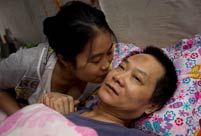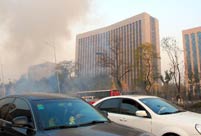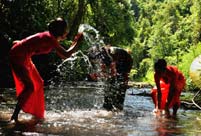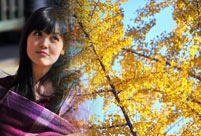Another major project is the construction of a new north branch, which aims to ease pressure on the Palace Museum and is expected to attract 3 million visitors after completion.
The north branch, which was a brick kiln for the court during the Qing Dynasty (1644-1912), covers 476,000 sq m in northwestern Haidian district, 40 km from the city center. The construction of the branch site is a priority on the museum's eight-year safety campaign.
In three to five years, according to plans, the site will house a repair center for large artifacts such as carpets, lamps and ancient vehicles, a research center for technology conservation, an exhibition space, a digital center and a palace garden center.
One of the first projects at the site is a training workshop for palace-style architecture construction, which had an opening ceremony on Nov 9.
During the first eight-day training sessions, 15 wood-workers for the museum will receive classes on such skills as reading ancient architectural drawings, the characteristics of the Forbidden City architecture and the repair of palace-style architecture.
"A tradition of nearly 300 years, the palace-style architecture craft once only served the royal family and absorbed the best techniques nationwide, developing many strict rules," says Li Yongge, a teacher for the workshop who is a Palace Museum researcher as well as the state-level intangible cultural heritage inheritor of palace-style architecture.
"We are losing these rules, materials and techniques," Li said. "What we are doing is a race against modernization."
Shan said at the ceremony, "The craft of Palace-style architecture has played a significant role in building, repairing and protecting the nearly 600-year-old Forbidden City. What we value is not just the architecture complex itself, but the building technique and its inheritance."
The other project launched the same day and expected to be completed in 233 days is a palace garden research center.
The center covers 55,000 sq m and includes a teaching area and culture zone. A greenhouse is already in use.
"The project will significantly improve the cultivation of ornamental plants and flowers within the main site of the Palace Museum, and eliminate potential safety hazards," Shan said, adding that the garden research center will be open to the public when it is completed.
Taipei Palace Museum Director Fung Ming-chu visited the north branch site and attended the opening ceremony while in Beijing for the fourth Two Cross-Straits Palace Museums Symposium.
"I heard about the north branch construction for the first time this April when Director Shan visited Taipei Palace Museum, and I am amazed that the site has already functioned this fast," Fung said, adding that a 45,000-sq-m new south branch site for the Taipei Palace Museum is still at the stage of foundation a laying after 12 years' planning.
"Drawing support from social forces, the two Palace Museums are doing their best to make their collections better-known to the public," Fung said. "I am sure the two will have a lot of experience exchanges and continue to learn from each other in the future."

 Luxury-cars parade held in Dubai
Luxury-cars parade held in Dubai Special forces take tough training sessions
Special forces take tough training sessions Fire guts 22-storey Nigeria commercial building in Lagos
Fire guts 22-storey Nigeria commercial building in Lagos A girl takes care of paralyzed father for 10 years
A girl takes care of paralyzed father for 10 years A record of Beijing air quality change
A record of Beijing air quality change In pictures: explosions occur in Taiyuan
In pictures: explosions occur in Taiyuan Live a harmonious life in Pu'er, SW China
Live a harmonious life in Pu'er, SW China Weekly Sports Photos
Weekly Sports Photos Gingko leaves turn brilliant golden yellow in Beijing
Gingko leaves turn brilliant golden yellow in Beijing Maritime counter-terrorism drill
Maritime counter-terrorism drill Loyal dog waits for master for six months
Loyal dog waits for master for six months The catwalk to the world of fashion
The catwalk to the world of fashion  China in autumn: Kingdom of red and golden
China in autumn: Kingdom of red and golden National Geographic Traveler Photo Contest
National Geographic Traveler Photo Contest Living in an urban village: 'Iron-digger' Xiong Sansan
Living in an urban village: 'Iron-digger' Xiong SansanDay|Week|Month